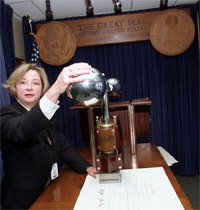Fact Sheet
Bureau of Public Affairs
Washington, DC
April 1, 2002 In the Department of State, the term "Great Seal" has come to include not just the die, but the counter-die, the press, and the cover, or cabinet in which it is housed, as well. These stand in the Exhibit Hall of the Department, inside a glass enclosure which is kept locked at all times, even during the sealing of a document. The mahogany cabinet's doors are also kept locked and the press is bolted and padlocked in position except when in use. The seal can be affixed only by an officer of the Department of State, under the authority of its custodian, the Secretary of State. When there are documents ready for sealing, one of the officers carries them to the enclosure where the Great Seal is kept and prepares them for impressing.
In the Department of State, the term "Great Seal" has come to include not just the die, but the counter-die, the press, and the cover, or cabinet in which it is housed, as well. These stand in the Exhibit Hall of the Department, inside a glass enclosure which is kept locked at all times, even during the sealing of a document. The mahogany cabinet's doors are also kept locked and the press is bolted and padlocked in position except when in use. The seal can be affixed only by an officer of the Department of State, under the authority of its custodian, the Secretary of State. When there are documents ready for sealing, one of the officers carries them to the enclosure where the Great Seal is kept and prepares them for impressing.
First, a 3-3/4-inch, scalloped, blank paper wafer of off-white linen stock is glued in the space provided for it to the left of the document's dating clause. If ribbons are used in binding the document, they are run under the paper wafer and glued fast. Second, the document is inserted between the counter-die, with the wafer carefully lined up between them. Third, the document is held in place with the left hand and the weighted arm of the press is pulled sharply forward with the right hand, from right to left. This drives the die down onto the wafer, document, and counter-die, which impresses the seal in relief. The die is then raised, releasing the document and allowing for its removal. When an envelope containing letters of credence or recall is to be sealed, the wafer is impressed first, and then glued to the sealed envelope, leaving the envelope itself unmarked.
Read all about the Great Seal and its history [pdf], from 1776 to present day.
The Office of Electronic Information, Bureau of Public Affairs, manages this site as a portal for information from the U.S. State Department. External links to other Internet sites should not be construed as an endorsement of the views or privacy policies contained therein.
